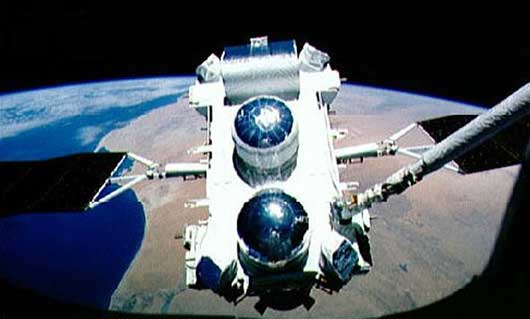[/caption]From 1991 to 2000, the Compton Gamma Ray Observatory dominated the search for the largest explosions ever observed in the cosmos: gamma-ray bursts (or GRBs). Unfortunately after nearly a decade of highly successful observations, June 4th 2000, NASA made the unpopular decision to de-orbit the observatory in response to a mechanical failure on the spacecraft (despite protests by some scientists, pointing out that the observatory could have continued operations).
To one scientist, Jim Ryan, the demise of the project he had tirelessly worked on since 1984 was a hard pill to swallow. However, in a surprise turn of events, the US Department of Energy tracked down Ryan and asked whether his research could be applied a little closer to home. In a flash of inspiration, the scientist realised spare parts left over from the Compton Gamma Ray Observatory could be used to pinpoint emissions from a potential “dirty bomb”, possibly providing security services with an early warning capability against a radioactive terrorist attack…
Although a dirty bomb has never been detonated and remain a speculative means by terrorists to cause maximum disruption to a populated area, the Department of Energy considers the threat to be very real. This is probably because a small amount of radioactive material could be used in the construction of a relatively cheap conventional bomb and plans by groups to use such weaponry have been uncovered in the past. The key power of a dirty bomb (otherwise known as a “radiological dispersal device”) isn’t the immediate health risk to a local population (apart from the obvious damage that could be caused by the conventional explosives used in the device), it is the lasting fear, panic and economic damage such a terror attack could cause. The residual radiation left over from a dirty bomb is of course a concern, but studies show that it is the psychological damage of such an attack that would have the greater effect.
So, the Department of Energy gave Dr Ryan a call to ask whether his work at the University of New Hampshire’s Space Science Center could be used to seek out radioactive devices. At the time, he was working on an instrument to be sent within the orbit of Mercury to detect low energy neutrons being emitted from the Sun. It just so happened that the neutron energy range matched that of the emission from plutonium.
“You don’t have to be an astrophysicist to see the connection,” Ryan commented on the government interest in using his techniques to search for nuclear devices on Earth.
However, during a visit to a National Guard exercise on Cape Cod, Jim Ryan was inspired by another space mission. The exercise carried out last year was to test security agent’s ability to track down dirty bombs (not nuclear weapons containing plutonium). Dirty bombs emit a different type of radiation (not the low energy neutrons emitted from a plutonium device), and Ryan realised that parts from his old and beloved Compton Gamma Ray Observatory may be resurrected to help serve national security tasks. Rather than manually scanning suspect radioactive devices with a hand-held Geiger counter, the gamma ray radiation can be detected at a safe distance and pinpointed. The problem with Geiger counters is that although they detect gamma radiation, you have to be standing right next to the radioactive source to know where it is. Using Compton Gamma Ray Observatory techniques can make the search safer and a lot more accurate.
“It lives on and does something that is useful to society as well as pure academic science,” Ryan said during a presentation to a Homeland Security conference in May. “[It is] poetic justice,” that the techniques by the spacecraft will be re-used by the modern fight against international terrorism.
Source: Boston.com


Clearly that R2 Unit has a Bad Motivator.
Silver Thread has obviously been looking for an appropriate time to use that comment. He gave up and used it here. (I also liked Star Wars.)
My response was to check on the type of instruments that were used on the Compton Gamma Ray Observatory. My understanding of what I found was limited since they expressed things in electron volts rather than wavelengths but I did see that they were pretty good in terms of angular (sp?) resolution.